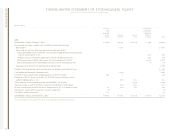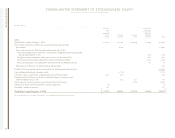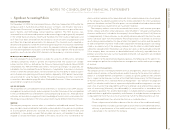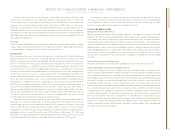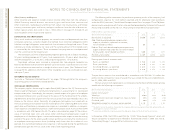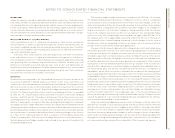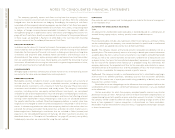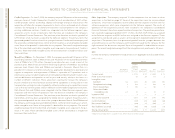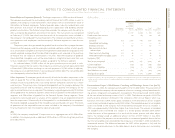IBM 2004 Annual Report Download - page 51
Download and view the complete annual report
Please find page 51 of the 2004 IBM annual report below. You can navigate through the pages in the report by either clicking on the pages listed below, or by using the keyword search tool below to find specific information within the annual report.
NOTES TO CONSOLIDATED FINANCIAL STATEMENTS
49
International Business Machines Corporation and Subsidiary Companies
a. Significant Accounting Policies
basis of presentation
On December 31, 2002, the International Business Machines Corporation (IBM and/or the
company) sold its hard disk drive (HDD) business to Hitachi, Ltd. (Hitachi). See note c,
“Acquisitions/Divestitures,” on pages 60 and 61. The HDD business was part of the com-
pany’s Systems and Technology Group reporting segment. The HDD business was
accounted for as a discontinued operation under accounting principles generally accepted
in the United States of America (GAAP) and therefore, the HDD results of operations and
cash flows have been removed from the company’s results of continuing operations and
cash flows for all periods presented in this document. The financial results reported as
discontinued operations include the external original equipment manufacturer (OEM) HDD
business and charges related to HDDs used in the company’s eServer and Storage prod-
ucts that were reported in the Systems and Technology Group segment. The discontinued
operations results do not reflect HDD shipments to the company’s internal customers.
principles of consolidation
The Consolidated Financial Statements include the accounts of IBM and its controlled
subsidiary companies, which in general are majority-owned. The accounts of variable
interest entities (VIEs) as defined by the Financial Accounting Standards Board (FASB)
Interpretation No. 46(R) (FIN 46(R)) (see note b, “Accounting Changes,” on page 56), are
included in the Consolidated Financial Statements, if applicable. Investments in business
entities in which the company does not have control, but has the ability to exercise signifi-
cant influence over operating and financial policies (generally 20-50 percent ownership),
are accounted for using the equity method. The accounting policy for other investments
in securities is described on page 54 within “Marketable Securities.” Other investments are
accounted for using the cost method.
use of estimates
The preparation of Consolidated Financial Statements in conformity with GAAP requires
management to make estimates and assumptions that affect the amounts that are reported
in the Consolidated Financial Statements and accompanying disclosures. Although these
estimates are based on management’s best knowledge of current events and actions that
the company may undertake in the future, actual results may be different from the estimates.
revenue
The company recognizes revenue when it is realized or realizable and earned. The com-
pany considers revenue realized or realizable and earned when it has persuasive evidence
of an arrangement, delivery has occurred, the sales price is fixed or determinable, and
collectibility is reasonably assured. Delivery does not occur until products have been
shipped or services have been provided to the client, risk of loss has transferred to the
client and client acceptance has been obtained, client acceptance provisions have lapsed,
or the company has objective evidence that the criteria specified in the client acceptance
provisions have been satisfied. The sales price is not considered to be fixed or determinable
until all contingencies related to the sale have been resolved.
The company reduces revenue for estimated client returns, stock rotation, price pro-
tection, rebates and other similar allowances. (See Schedule II, ”Valuation and Qualifying
Accounts and Reserves” included in the company’s Annual Report on Form 10-K). Revenue
is recognized only if these estimates can be reliably determined and if the client has eco-
nomic substance apart from the company. The company bases its estimates on historical
results taking into consideration the type of client, the type of transaction and the specifics
of each arrangement. Payments made under cooperative marketing programs are recog-
nized as an expense only if the company receives from the client an identifiable benefit
sufficiently separable from the product sale whose fair value can be reasonably estimated.
If the company does not receive an identifiable benefit sufficiently separable from the
product sale whose fair value can be reasonably estimated, such payments are recorded
as a reduction of revenue.
In addition to the aforementioned general policies, the following are the specific rev-
enue recognition policies for multiple-element arrangements and for each major category
of revenue.
Multiple-Element Arrangements
The company enters into multiple-element revenue arrangements, which may include any
combination of services, software, hardware and/or financing. To the extent that a deliver-
able(s) in a multiple-element arrangement is subject to specific guidance (like software
that is subject to the American Institute of Certified Public Accountants (AICPA) Statement
of Position (SOP) No. 97-2, “Software Revenue Recognition”—see “Software” on pages 50
and 51) on whether and/or how to separate multiple-deliverable arrangements into sep-
arate units of accounting (separability) and how to allocate value among those separate
units of accounting (allocation), that deliverable(s) is accounted for in accordance with
such specific guidance. For all other deliverables in multiple-element arrangements, the
guidance below is applied for separability and allocation. A multiple-element arrangement
is separated into more than one unit of accounting if all of the following criteria are met.
•The delivered item(s) has value to the client on a standalone basis.
•There is objective and reliable evidence of the fair value of the undelivered item(s).
•If the arrangement includes a general right of return relative to the delivered item(s),
delivery or performance of the undelivered item(s) is considered probable and
substantially in the control of the company.
ibm annual report 2004









